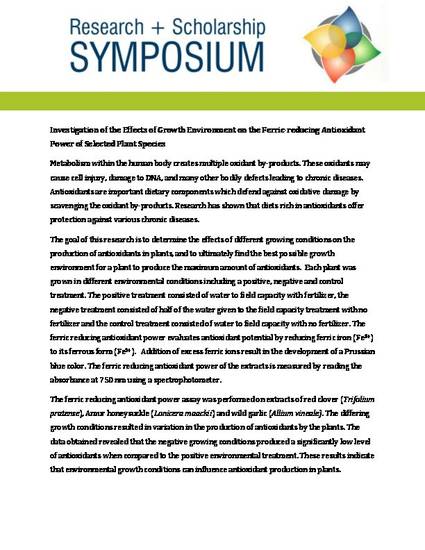
- Antioxidant,
- plant environment,
- medicinal plants
Metabolism within the human body creates multiple oxidant by-products. These oxidants may cause cell injury, damage to DNA, and other complications leading to the development of chronic disease. Antioxidants are important dietary components which defend against oxidative damage by scavenging the oxidant by-products. Research has shown that diets rich in antioxidants offer protection against various chronic diseases.
The goal of this research is to determine the effects of varying growing conditions on the production of antioxidants, and to ultimately find the best possible plant-growth environment for maximum production of antioxidants. Each plant was grown under three different environmental conditions; positive, negative, and control treatment. The positive treatment consisted of supplying water to field capacity with fertilizer, the negative treatment consisted supplying half of the water required to reach field capacity with no fertilizer, and the control treatment consisted of supplying water to field capacity with no fertilizer. Ferric reducing antioxidant levels were then determined. The ferric reducing antioxidant power evaluates antioxidant potential by reducing ferric iron (Fe3+) to its ferrous form (Fe2+). Addition of excess ferric ions result in the development of a Prussian blue color. The ferric reducing antioxidant power of the extracts was measured by reading the absorbance at 750 nm using a spectrophotometer.
The ferric reducing antioxidant power assay was performed on extracts of red clover (Trifolium pratense), Amur honeysuckle (Lonicera maackii) and wild garlic (Allium vineale). The differing growing conditions resulted in variation in the production of antioxidants by the plants. The data obtained revealed that the plants grown under the negative treatment produced a significantly lower level of antioxidants when compared to the plants grown under the positive treatment. These results indicate that growing conditions can influence antioxidant production in plants.
Available at: http://works.bepress.com/denise_simpson/69/
